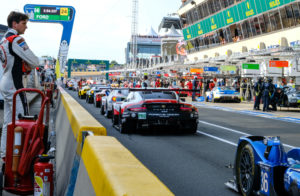 The greatest test of endurance in automotive racing took place earlier this month. Here’s what you need to know!
The greatest test of endurance in automotive racing took place earlier this month. Here’s what you need to know!
The Monster of Le Mans
If you saw the recent film “Ford v Ferrari,” you witnessed the true story of American and British engineers and designers, led by automotive designer Carroll Shelby and his friend and British driver Ken Miles, who were recruited by Henry Ford II and Lee Iacocca with the mission of building the Ford GT40. The objective of this new race car was to finally defeat the dominant Italian racing team of that time, Ferrari, at the 1966 24 Hours of Le Mans race. In case you missed it, the 90th running of the race itself was recently held June 11 -12, 2022, at the Circuit de la Sarthe, a combination of permanent track connected to public streets, roughly 8.5 miles long in Le Mans, France.
###
UPDATE: In case you missed it, the 90th running of the race was recently held June 11 -12, 2022 at the Circuit de la Sarthe, a combination of permanent track connected to public streets, roughly 8.5 miles long in Le Mans, France and won by Toyota for its fifth straight victory.
###
Why This Is Different
The 24 Hours of Le Mans is one of the oldest and most well-known of all motor races. The race is not preoccupied with which car is fastest, but which car can travel the farthest distance over the 24-hour duration. The event is a test of endurance, rather than outright speed. Because it’s common for teams to use this race to test new technology, many advancements have arisen from the research and development put into the series. Fuel efficiency is one area that has been a focus because the more fuel-efficient the car is, the fewer refueling pit stops are needed. The race is run by teams of three drivers who drive in shifts that can last 45 minutes all the way up to 4 hours in cars that routinely hit speeds of 200+ mph on the 3.7-mile Mulsanne Straight. Cars that survive will travel roughly 3,300 miles and go through as many as 12 sets of tires and 500 gallons fuel during the ordeal.
The Women of Le Mans
While men have dominated most motorsport events, that’s not the case with Le Mans. From the start of the 24 Hours of Le Mans in 1923, 64 women drivers have raced representing 15 countries and finished the race 77 times. Anne Charlotte is arguably the most successful to date, competing on 10 occasions between 1974 and 1983. Her best finish was crossing the checkered flag in sixth place, driving a Porsche 935 in 1981. Le Mans has also seen 28 crews composed entirely of women.
The Takeaway: It’s Not a Sprint, It’s a Marathon
Not unlike this amazing event, investing and retirement planning is as much about endurance as it is about beating the market. There will always be setbacks and challenges, but that’s what the journey is all about. Having a focus on following a well-designed plan and keeping your emotions under control is precisely how to come out a winner in the end.
Sources
- https://www.24h-lemans.com/en
- https://www.cnbc.com/2016/06/17/race-3300-miles-in-a-supercar-its-time-for-24-hours-of-le-mans.html
- https://www.wired.com/story/24-hours-le-mans-logistics/
- https://www.caranddriver.com/news/a27672259/all-about-24-hours-of-le-mans-race
- https://www.hotcars.com/24-hours-of-le-mans-facts/


